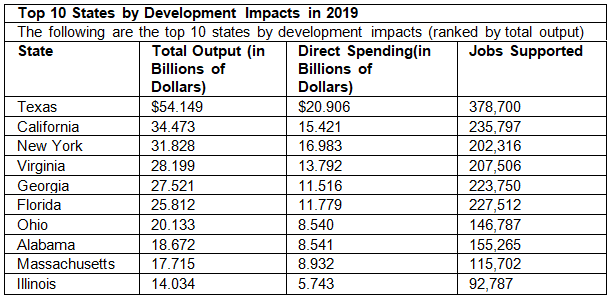Report suggests the value is $1.14 trillion with support for 9.2 million jobs

New development and the operation of existing commercial real estate buildings contributes a huge amount to the US economy.
That’s according to a new report from NAIOP, the Commercial Real Estate Development Association, which calculates that the sector supports 9.2 million jobs and contributed $1.14 trillion to the economy in 2019.
Both figures increased from the previous year as detailed in the annual Economic Impacts of Commercial Real Estate study which measures the contributions to GDP, salaries and wages generated, and jobs created and supported from the development and operations of commercial real estate.
"The U.S. economy is nearing 11 years of expansion, growing consistently since July 2009 and making it the longest in American history," said Thomas Bisacquino, NAIOP President and CEO. "Commercial real estate remains as a significant economic driver, facilitating growth and creating valuable jobs. Despite slowing global and U.S. fiscal growth, the economy's expansion is expected to extend beyond 2020. This is good news for our industry, as steady demand will drive new construction and development."
Property types
The study broke out several key measures by commercial real estate industry sector:
- Office construction expenditures totaled $50.8 billion in 2019, up 5.4% from 2018, building on its 12.3% gain the previous year.
- Retail construction expenditures totaled $14.4 billion in 2019, a decrease of 15.1% from 2018. That marks four straight years of decline; expenditures fell 9.5% in 2018, 0.8% in 2017 and 7.0%in 2016. The last time retail construction spending increased was in 2015.
- Warehouse construction outlays rose in 2019, gaining 12.6% from 2018. Construction spending had declined slightly in 2018 (0.7%) after increasing in each of the preceding seven years.
- Industrial construction spending, which fell sharply in 2015 and 2016 before increasing in 2017 and 2018, declined 31.7% in 2019. This reflects the manufacturing sector's weaker performance during the year, caused in part by tariffs that have disrupted foreign trade.

The full report is available at naiop.org/contributions2020



